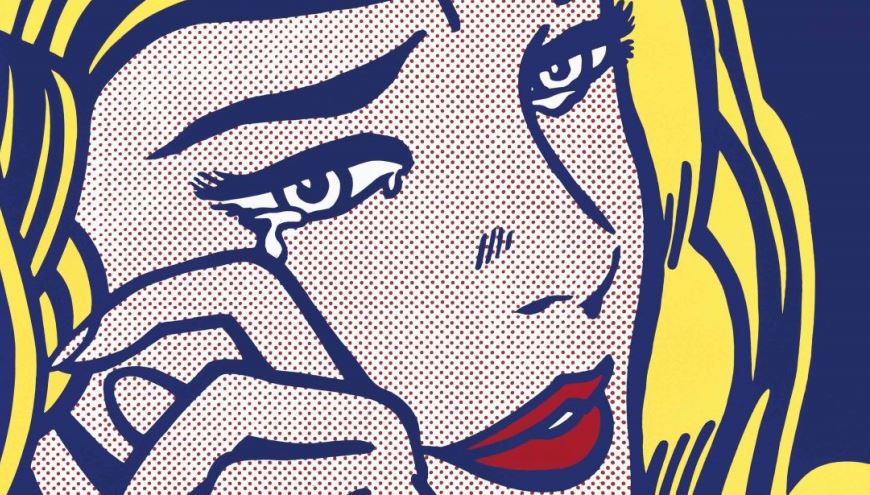Like Andy Warhol, James Rosenquist or Jasper Johns, Roy Lichtenstein is a key figure from the pop art movement. Artalistic delves deep into this American artist’s career through ten of his most famous works of art.
Roy Lichtenstein: iconic pop artist
A key figure in contemporary art
When you think of Pop Art Roy Lichtenstein (1923-1997) is bound to come to mind. His work was influenced by comic strips and advertisements. He uses bold colors and Ben-Day dots to create secondary colors. This technique is used in printing, especially in comics, and photoengraving to create shading and secondary colors. His work was and continues to be completely unique within its genre.
Roy Lichtenstein’s contributions to pop art
Roy Lichtenstein became interested in art in his teens and took watercolor classes at Parsons School of Design in 1937 and various art classes at the Art Students League in 1940. Lichtenstein went on to study fine arts at Ohio State University. His studies were interrupted in 1943 when he was drafted into World War II. After completing his service in Europe he returned to Ohio State in 1946 to finish his undergraduate and master’s degrees in fine arts.
In the 1950s and 60s he experimented with different techniques, creating commentary pieces that brought Abstract Expressionist paintings of the time into question. Instead of creating subject-less art, Lichtenstein borrowed imagery from comic books and advertising.
His vision was a major breakthrough as he churned out increasingly powerful pieces exploding with color and exceptional compositions.
10 seminal pieces from pop artist Roy Lichtenstein
1. Masterpiece (1962)

Masterpiece is a perfect example of Roy Lichtenstein's iconic style, combining comic book imagery and painting. Lichtenstein saw pop art as being inseparable from popular culture. For him they complemented and enriched each other.
In 2017, the painting Masterpiece was sold for a record $165 million to the collector Steven A. Cohen.
2. Drowning girl (1963)

Drowning Girl is considered to be one of Roy Lichtenstien’s most significant works and has been described as a masterpiece of melodrama. It is a prime example of Lichtenstein’s painterly work that imitates mechanized reproduction. It depicts a woman in a tragic situation – a theme that he would revisit during the mid-1960s. This piece was derived from a 1962 DC Comic, both the imagery and text featured in the thought bubble are elements taken from the original work. Roy Lichtenstein’s reappropriation of images such as this one has been a hot topic of debate in the art world.
3. Look Mickey (1961)

Look Mickey is Roy Lichtenstein’s first piece that took a painterly approach to pop culture. It was also the first time he used Ben-Day dots, speech bubbles and comic imagery. For this piece he borrowed elements from a drawing in a 1960s children’s book entitled Donald Duck: Lost and Found.
4. Crying Girl (1963)

Another famous pop art painting by Roy Lichtenstein, Crying Girl gives us a glimpse of the artist's style, incorporating closely framed compositions of the subjects, large flat areas of color and heavy black outlines. This very graphic and striking comic book inspired visual vocabulary became Lichtenstein’s signature style. Crying Girl is the name of two different pieces, an offset lithograph on lightweight, off-white wove paper and a porcelain enamel on steel.
5. Happy Tears (1964)

Roy Lichtenstein's pop art is full of portraits of tearful women racked by worry, sadness and grief, often caused by love affairs with domineering men. Happy Tears is yet another comic-based woman featuring “hard, crisp, brittle and uniformly modish in appearance.” However, this painting depicts a woman crying because she is happy about something that is outside of the closely cropped canvas.
6. Whaam! (1963)

Whaam! is another famous Roy Lichtenstein painting inspired by the comic book All American Men of War. This diptych is part of a series on war that he created between 1962 and 1964. This piece was most likely inspired by his time serving in the US Army during World War II.
7. In The Car (1963)

In the car is the name of two different pop art paintings created by Roy Lichtenstein. The larger of the two has been part of the Scottish National Gallery of Modern Art in Edinburgh’s permanent collection since 1980. This is one of many paintings by Lichtenstein that depict a man and a woman in a tense melodramatic scene. Here he used vertical lines to convey the sense that the car is in motion.
8. Hopeless (1963)

This painting entitled Hopeless features one of Roy Lichtenstein's main themes, a woman in in the throes of romance. The thought bubble is also one of this American artist’s trademarks.
9. Ohhh… Alright… (1964)

What would Roy Lichtenstein's pop art be without the presence of the female subject? Isn't love, and its joy and sorrow, the most universal theme in art history? This painting is based on an image from the comic book Secret Hearts (1963).
10. Oh, Jeff… I love you too… (1964)

Oh Jeff, I love you too but... has been heralded as Roy Lichtenstein’s Mona Lisa. Here we see another blue-eyed blonde haired woman with sad eyes seemingly giving into a doomed love affair. We see here, again, Lichtenstein’s use of enlarged Ben-Day dots, bold outlines and images that were cropped and magnified from the original source materials.
Regardless of whether you love or hate Roy Lichtenstein’s pop art, you might find a piece of art you would like to invest in by browsing our carefully curated galleries of paintings, sculptures, photographs and drawings by well-established and emerging artists. When purchasing with Artalistic you can rest assured that you are dealing with one of the world’s leading online art investment platforms. We bring you our discerning eye for art, a team of experts you can trust and a safe and secure interface. Stay in the know by following our art blog!
 English
English Français
Français


You must be logged in to post a comment.
Click here to log in